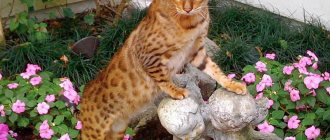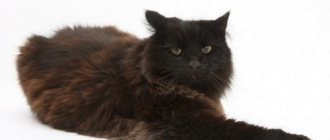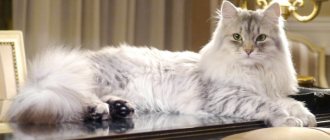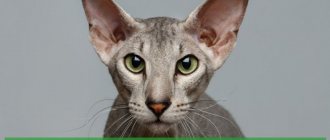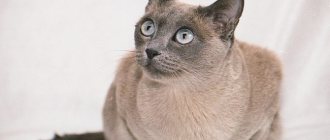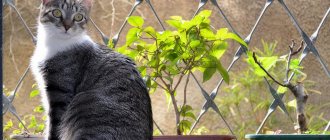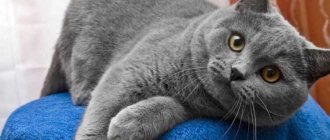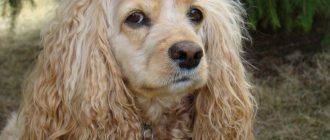Can an ordinary domestic cat combine the characteristics of a furry purr and a mythical creature? The answer to this strange question is clear – maybe! A striking example is the “werewolf” cat. This is not fiction, but a real attractive animal that knows how to be an affectionate and gentle animal.
The breed of "werewolf" cats is called the Lyka . If you literally translate the unusual Greek word “Lykoi”, you get “wolf”. When choosing a name for the new breed of werewolf cats, breeders sought to emphasize the unique and somewhat strange appearance. At the same time, the Lykoi cat remains a typical representative of its family, combining many diverse character traits.
Origin story
Translated from Greek, the word “Lykoi” means “werewolf”, “werewolf”. It's scary, isn't it?
But in fact, if you dig deeper, the reviews about these cats are only positive. And there are many of them. Their habits are identical to those of other cats, but in their devotion and hyperactivity they are very similar to dogs.
The story of the birth of the Lykoei is as follows: in 2010, on a farm in Virginia, an ordinary domestic cat gave birth to two unusual-looking babies: the hair on their bodies grew unevenly, leaving some areas almost bald.
Farm owner Patti Thomas, deciding that these kittens were distant relatives of the Devon Rex or Sphynx, called Gobble breeders, well-known in those places. The Gobble couple became interested in the babies and, having studied all the available information and the results of DNA tests, came to the conclusion that neither rexes nor sphinxes have anything to do with them. And this was already an unambiguous indication of the emergence of a new breed.
As it turned out, a similar incident occurred in Tennessee. A random natural mutation made it possible to bring new cats onto the international stage, which were initially called opossum cats (due to the similarity of the coat with the hair of opossums), but then they changed their name to a more original one - Likoi. You won’t know who was the first to come up with the idea of connecting mysticism, but it’s hard not to agree that these cats deserve a bright and memorable name.
In 2012, the breed was officially recognized by the TICA association. Since then, only those who support the activities of TICA and agree with its charter can engage in breeding werecats. The breed belongs to the “developing” category, i.e. it is not yet established and is being studied.
Health
Likoya can hardly be called a cute cat.
Maybe visually Liki seems not quite healthy, due to her strange appearance, but in reality this is not the case. The breed is surprisingly strong and resistant to all kinds of diseases. This fact has been confirmed by repeated genetic and veterinary studies. True, geneticists do not exclude the possibility of some hidden anomalies. So far, nothing has been revealed in this regard.
There is no exact information about the life expectancy of Lykoi, since the breed is new. Based on existing data, demon cats with proper care can easily live up to 15-16 years.
Standard
Likoi weighs little: the female is only 2-3 kg, the male is slightly larger - up to 4.5 kg.
| Standard | Description |
| Head | Wedge-shaped, with smooth features. The muzzle is small, the chin is rounded, the nose is wide and slightly elongated, its tip is directed downward. The forehead is sloping. The whisker pads are small but fleshy. |
| Ears | They are large, their tips are pointed, and their base is wide. Widely spaced. |
| Eyes | Open, almond-shaped, piercing, attentive gaze. Outlined in dark. The iris can be blue, green, gray, but those with yellow and gold eye colors are more highly valued. |
| Torso | Strong, flexible, dexterous. The limbs are of medium length, the fingers are long, thin, and the pads are dark. |
| Tail | Thin, short, tapering towards the end. The neck is medium size. |
| Wool | The coat is atypical for cats. The guard hair is loose, but very soft and pleasant to the touch (like human hair). It can be of medium length or very short. There is no undercoat. In the area of the muzzle - around the nose and eyes - there is no hair at all. |
Researchers who studied the fur of Lykoi found that they were missing some important hair follicles, and those follicles that were present lacked a balance of important components. This is a natural mutation. But the “plus” is that the change in coat pattern in Lykoi cats is several times faster than in cats of other breeds.
Physical characteristics and character traits that do not allow animals to participate in exhibitions:
- blindness;
- finger mutation, polydactyly;
- creases, knots or other defects in the tail;
- strabismus;
- cowardice, aggressive behavior;
- body completely covered with fur;
- different coat color;
- undescended testicles.
Are you interested in the breed and would you like to buy a kitten? Get ready to face difficulties. There are only 3 officially registered nurseries in the world: in Michigan (USA), Oklahoma (ibid.) and Moscow (Murmulet nursery). There are private breeders in France, the USA and Canada. Three-month-old toddlers (kittens younger than this age are not put up for sale) are expensive: blue and bicolor kittens (which are considered not so spectacular) are estimated at about 100,000 rubles, and the so-called roan color (with an abundance of white hair on the body) - from 160,000 rubles and above .
Interesting facts about werecats
Some interesting facts about cats with demonic appearance:
- before the appearance of the Lykoi, roan coat color could be seen exclusively in horses;
- representatives of this population of cats sometimes become completely bald during molting, but soon grow back with fur;
- They are characterized by one quirk - periodically they freeze in a praying pose (like gophers), pressing their paws to their chest. They can remain in this state for a long time. If you extend your hand to them at this time, they will extend their paw in response.
Lykoi are extraordinary not only in appearance, but also in their behavior. This causes conflicting emotions among others. By appreciating their unique beauty, you can acquire a faithful and kind friend.
Character and behavior
The frightening appearance of the Lykoi does not fit in with their character. These are very kind and affectionate creatures who adore members of their family - the pack in which they grow up. But they tolerate other animals rather than truly love them. This is especially true for large breed dogs and big cats. If other animals claim dominance in the house, fights cannot be avoided. Likoy will perceive them as rivals and constantly provoke them into a showdown. And small animals such as birds and fish are exclusively hunted.
Remember the following: the Lykoi are very wary of strangers at first, and if they notice a threat (or think that the person wants to cause harm), they can rush at him without hesitation.
Likoy lying on the sofa for hours is from the realm of fantasy. They are curious to the extreme, they love to climb higher and get deeper, rustle all the packages on their way, sniff and scratch all the boxes and cans, are interested in the food on your plate and the drops that you put in your nose. It is useless to brush them off, and to scold them is dangerous. Lykoi are very offended by the raised tone and poking, hide and refuse to come out for hours.
Lykoei expresses their activity in games and running around. If you have explained to your kitten since childhood what can and cannot be done, you will not have any problems in the future. Moreover, if you take care of toys in advance, and even better, give your child a play corner in the apartment.
It is not necessary to buy a bulky and expensive design: a small one is enough. A couple of hammocks, a ladder, a closed house higher up, a rope, a soft place where you can sharpen your claws to your heart's content - that's all. You can buy the complex or make it yourself (there are many detailed instructions on the Internet).
Lykoi are excellent hunters. Not a single butterfly or fly will fly past your cat's little nose, not a single insect will run past. In nature, Likoya will be a real expanse: if you have a dacha or a house on the ground, take your Likoya there for a walk more often. He will enthusiastically catch insects, chase lizards and mice, wallow in thickets of grass and climb trees.
But it is not recommended to leave your pet unattended: a curious creature can easily go out to explore a neighboring area or street, and then move on. If you want to take your cat into the forest, be sure to wear a collar and leash.
Does your pet like to go for walks?
HomebodyWalking on the street
Regarding training: so far this issue has been studied little. The first reviews were quite contradictory: some owners claimed that, despite being human-oriented, Lykoi do not want to learn commands, others - that they carry out light commands like “carry the ball” easily and without problems. It can be assumed that something can be taught in a playful way. But specifically in the game, without using punishment, but only with encouragement.
Breeding
So, you have a Lykoi or even two of their representatives in your home. It is worth taking the chance to raise the offspring of these amazing animals, especially since due to the small number of nurseries, the sale of several kittens will bring significant income.
First you need to join a specialized club for breeders. For example, in European systems these are WCF, FIFE, etc., and in American systems - TICA, CFA. In the case of Lykois and difficulties with the recognition of this breed, be prepared for the fact that it will definitely be possible to join only TICA. Next, you need to start taking part in exhibitions, because without this, the cat cannot be officially admitted to breeding.
Likoy kittens are born completely black and then acquire the “gray hair” characteristic of this breed.
After all the preparations are completed, you can start looking for a match for your pet.
Criteria for choosing a partner
There are the following criteria for choosing a partner that are common to all cat breeds:
- health;
- pedigree or confirmation of breed purity;
- the opportunity to conclude an agreement with the owner, which will stipulate all rights to future kittens.
Cats should not be given for mating during their first heat; to obtain healthy offspring, it is necessary to skip 1-2 heats. The appropriate period is around 1 year of age. Males can be bred from the age of 14 months.
How often can a cat give birth?
Physiologically, a cat can give birth 4–5 times a year, but in this case the animal’s body works for wear and tear, exclusively producing offspring without adequate recovery after childbirth. You must understand that in this case, not only the cat’s health will suffer, but also the quality of the kittens.
The first birth should take place in the presence of an experienced veterinarian or with the ability to quickly contact him if something goes wrong.
When breeding, a caring owner must take into account the condition of the mother cat immediately after birth, as well as the presence of complications such as mastitis, inflammation of the uterus, and so on. If any such disease has occurred, then the cat can endure the next birth only after 10 months. Breeders who are members of the club, as a rule, deliver cats 3 times every 2 years.
Care instructions
Lykoi can be compared to babies, because they require careful and regular care, but, alas, they cannot really take care of themselves.
Bathing
Their skin is similar to the skin of sphinxes: it also secretes a viscous secretion and “sweats.” If you don't wash it off, it starts to smell unpleasant and stain everything around you. Every month the cat needs to be bathed: in warm water, using a special mild detergent. Human gels and shampoos often cause diarrhea, rashes and irritation.
“Doctor ZOO”, “Clandestine”, Cliny “Deep Cleaning” have proven themselves well: these are soft budget products that wash away dirt well and remove unpleasant odors. Dry the cat with his personal soft towel, and then dry it with a hairdryer or near a radiator.
Lykoei skin quickly “burns” in the sun: literally an hour or two in the sun and hello, reddened and painful skin! Therefore, do not allow the animal to lie on the open balcony.
If you live above the first floor, install special strong nets on the windows. Likoy, in the excitement of the hunt, will easily jump out of the window. Imagine if this is the eighth floor?
They shed profusely and often, so be prepared for daily brushing and frequent cleaning of the house.
Claws
His claws are trimmed every week: they grow very quickly. This does not cancel the purchase of a quality scratching post.
Eyes
The ears and eyes are looked after like the rest. If the eyes do not “flow”, then there is no need to touch them. If you notice pus in the corners or the cornea turns red, take the animal to the veterinarian as quickly as possible. Wax from the ears is cleaned with a cotton pad soaked in chlorhexidine or a piece of soft cloth. No lotions or water should be poured inside: this will provoke severe internal inflammation of the ear!
Teeth
Teeth are brushed once a week if the cat eats dry food, and 2 times if he eats natural food with a sufficient amount of meat. Only special toothpaste is suitable: with glycerin, triphosphate or carrageen in the composition. Brush: a regular baby brush (with trimmed bristles), a finger brush, or a piece of gauze wrapped around your finger.
You need to get used to cleaning your face from an early age. If your pet is categorically against the procedure or you do not dare to brush his teeth yourself, contact a veterinary clinic. There they will perform mechanical (under local anesthesia and sedative) cleaning or laser cleaning (a more gentle, but also more expensive procedure).
How to choose a kitten
Likoi kittens
When choosing a Likoi kitten, it is recommended to pay attention to a number of points. Required availability:
- black fur;
- on the face of a bald mask;
- bald patches on the pads of the paws.
It is advisable to take with you a photo of the real Lykoi. The demand for the breed is growing tirelessly; unscrupulous breeders take advantage of this and often deceive buyers.
Buying a kitten is not easy due to the rarity of the breed. There are about 7 nurseries around the world (most are in the USA) where you can buy true Lykoi. Even there, the kitten will not be sold immediately; you will have to sign up and wait a long time for your turn.
Kitten care
After birth, kittens live in a nursery or with the owner of the mother cat for up to 12 weeks. Only then does the distribution begin. By this time, babies are accustomed to eating solid food, relieving themselves in a tray, and are routinely vaccinated.
Likoev kittens quickly get used to a new place
So that the kids do not experience discomfort from changing their place of residence, the new owners prepare everything in advance. You need a comfortable bed and a few small toys. Be sure to block access to electrical wires, indoor plants, cleaning products and anything that could injure a curious new resident. In just a few days, the kittens adapt.
How much does a kitten cost approximately?
Since the breed is rare in Russia, it is difficult to say the exact price for kittens. It is known that the cost starts from 150 thousand rubles. Defective copies can be purchased from 90 thousand rubles. Additionally, the costs of delivery from America and preparation of accompanying documentation are added.
Catering
Their diet should be balanced and satisfying: their metabolism is such that they want to eat often and in large quantities. And bare areas of the body contribute to accelerated heat exchange and a large waste of energy. But by overfeeding your cat, you will cause him to develop obesity, heart problems and diabetes.
Usually cats are fed 2 times a day. Likoev should be fed 5-6 times, giving small portions (taking into account the general weight recommendations). You cannot mix natural food and ready-made food: choose one. Otherwise, stomach problems cannot be avoided.
Likoi drink only water: clean, fresh and at a comfortable temperature (not ice, but not hot either). You should wash the bowl and pour fresh water in the mornings and evenings: squeamish cats will not drink dirty liquid.
Natural products
What should be on the menu at your lykoi? Since the cat is an obligate predator, meat is the determining product in its diet.
- Allowed: beef (nutritious, but a bit heavy), rabbit (hypoallergenic), poultry (chicken, turkey, quail), pork (shoulder, fillet, neck - small pieces), horse meat (nutritious and hypoallergenic), nutria (rich in vitamins), kangaroo meat, crocodile meat, snakes, mice, day old chicks. The meat is served raw (previously doused with boiling water), in small pieces, mixed with porridge or vegetables.
- Offal: heart, liver (boiled), ventricles, cartilage, necks, heads, tongues, lungs, testes, kidneys, spleen, tripe, udder.
- Fish: flounder, cod, haddock, navaga, pink salmon, herring, trout, carp, salmon, ivasi, omul, sockeye salmon. It is better to boil it, removing the fins and heads. Farmed fish are often laced with drugs. You shouldn’t buy it for either your cat or yourself.
- Cats get their fiber from vegetables. It helps the digestive tract function. It is allowed to give zucchini (raw and boiled), beets (boiled), cauliflower, broccoli, carrots, spinach. Many people enjoy gnawing on radishes and cucumbers. From fruits: melons, watermelons, pears, apples.
- Dairy products: biokefir and bifidokefir (fat content - 2-4%), low-fat cottage cheese, hard cheese, fermented baked milk, natural yogurt, sour cream diluted with water. If a cat has been drinking cow's milk since childhood and does not have a negative reaction (diarrhea, vomiting), you can continue to give milk.
- Boiled egg yolk and quail eggs.
- Porridge: rice, buckwheat, oatmeal, pearl barley.
You should not give smoked, rotten, salted, fried, smoked, spicy or fatty meat. It is forbidden to feed wild bird meat (almost always infected with parasites) and lamb (poorly digested).
Recommended food
If you want to feed Lykoya with ready-made food, choose the Holistic line. It includes the following foods: Riverwood, Gather, Go Natural. Holistics deserve their high praise due to their good composition. Super-premium food is somewhat lower in quality, but cheaper. The rest - premium and economy - are poor in composition.
Below are the recommended holistic class foods. Links with the names of the food are clickable, on them you can, within our website, get acquainted with the descriptions of the food and read reviews from owners of Likoi cats.
| Holistic | Holistic | Holistic |
| Acana | Nutram | Primordial |
Feeding the werecat
Due to the lack of thick wool protection, they have a high level of thermoregulation. Therefore, they are quite gluttonous. This nuance is taken into account when preparing your pet’s daily diet. However, there is no need to overfeed, which will lead to obesity.
Diet
Premium cat food
When choosing food for a werewolf cat, it is preferable to choose premium, high-quality food. First of all, they look at the expiration date and composition. The feed should not contain soy, wheat, or corn. The most suitable brands: Royal Canin, Acana.
If the owner is inclined towards natural nutrition, then be sure to include in the menu:
- raw lean meat;
- sea fish;
- offal;
- quail eggs;
- porridge;
- boiled vegetables;
- fermented milk products.
It is strictly forbidden to give sausages, smoked meats, pickles, mushrooms, potatoes, sweets and baked goods. You cannot train your pet to accept food from the owner's table.
How often should you feed?
The intensity of feeding depends on the age of the animal. Up to 4 months, the number of meals reaches 6 times, then reduce to 5 and adhere to this regimen for a month. Over the next 4 months, they switch to four meals a day, and by the year they try to switch the pet to three meals a day. Starting from a year, two feedings a day will be enough.
Vitamin and mineral supplements
To prevent the development of vitamin deficiency, vitamin and mineral complexes are introduced into the diet. This is done twice a year. A veterinarian will help you make your choice.
Photo gallery
Below are photos of cats of the Likoi breed.
Owner reviews
In our country, the owner of the first catwolf (in the same 2016) was Maxim Perfilin, who a few months later pleased his Lykoi boy with a same-breed friend, also exported from the USA.
Maxim is sure that cats with such a mutation exist not only in America, we just don’t pay attention to them, treating them as if they were sick. At least cats with amazing “ron” hair have already been found in South Africa and Israel.
Maxim named his “firstborn” Gob-Gobblins Wolf Bimka and has not yet noticed his fundamental differences from an ordinary cat. Bimka has iron health and a cheerful disposition, as well as fur that makes experienced groomers fall into a trance.
Return to content
